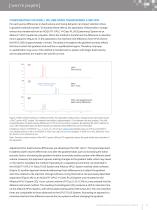
Dwell Volume and Extra-Column Volume: What Are They and How Do They Impact Method Transfer
1 /
9Pages
Catalog excerpts

[ WHITE PAPER ] Dwell Volume and Extra-Column Volume: What Are They and How Do They Impact Method Transfer? Paula Hong and Patricia R. McConville Waters Corporation, Milford, MA, USA A chromatographic separation is impacted by numerous factors, including the LC system and its characteristics. The impact of the chromatographic system on the separation may not be obvious until the method is transferred to another LC system or scaled to a different column dimension. By characterizing the system and understanding these differences, strategies can be undertaken to increase the success of methods transfer. These approaches can use software or hardware tools – including the ACQUITY™ instrument control software – or follow the USP <621> Chromatography guidelines for scaling to translating methods.1 INTRODUCTION Method transfer or method scaling across different instrument platforms can be affected by both dwell volume and extra-column dispersion. Each characteristic will have a very different effect on the chromatographic separation. Dwell volume is the volume required for the change in a gradient to reach the column, or the volume difference between the point of mixing and the head of the column. Dwell volume impacts the retention times of a gradient separation, but can also affect selectivity, particularly for early eluting compounds. Extra-column dispersion is a measurement of the broadening of a peak that occurs between the injector and the detector and excludes the column. Extra-column dispersion or volume impacts peak width, resolution, and the overall efficiency of a separation. In this review, the differences of these attributes across a variety of instruments will be examined, specifically for their impact on methods transfer. We will also review strategies to minimize the impact on the method transfer. These recommendations will follow the USP <621> guidelines. DWELL VOLUME MEASURING DWELL VOLUME For every chromatographic system, the dwell volume is a physical characteristic that is primarily a function of the pump. It represents the volume difference between the device that controls the delivery of the gradient and the head of the column. It is also commonly referred to as gradient delay volume. Dwell volume is impacted not only by the tubing (length and internal diameter (I.D.)), but also by any valves or mixers in the fluidic path up to the head of the column. To understand the variations among systems, we measured the volume difference of a programmed gradient and the delivery of said gradient to the detector (Figure 1). This was accomplished by using a gradient from 0–100% B where B contains a UV absorbent compound (in this case caffeine). Using a UV detector, we can then record the response of the UV absorber over time, which reflects the delay in the gradient delivery. For a more accurate assessment, the delay was calculated at 50% of the gradient. The analyses were conducted in triplicate with the average values recorded. This procedure has been extensively described in literature.
Open the catalog to page 1
[ WHITE PAPER ] The measured values (Figure 2), cover a range from <100 µL to over 1 mL for UPLC,™ UHPLC, and HPLC quaternary and binary systems. For each type of system, the pump characteristics determine the dwell volume. For quaternary pumps, changes in the gradient occur at the gradient proportioning valve (GPV). This valve, which is typically before the mixer, results in a greater dwell volume than in a binary system with the same mixer, tubing and valves, because the GPV is located before the solvent is pressurized by the pump. The total dwell volume not only includes the valve and...
Open the catalog to page 2
[ WHITE PAPER ] COMPENSATING FOR DWELL VOLUME WHEN TRANSFERRING A METHOD For each pump, differences in dwell volume and mixing behavior can impact retention times in gradient methods transfer. To illustrate these effects, the separation of flavonoids in orange extract was transferred from an ACQUITY UPLC H-Class PLUS (Quaternary) System to an Alliance™ HPLC (quaternary) System. When the method is transferred, the difference in retention time is apparent (Figure 3). In this separation, the retention time difference from UPLC (3A) to the HPLC (3B) is approximately 1 minute. The delay is...
Open the catalog to page 3
[ WHITE PAPER ] UPLC/UHPLC HPLC Amount of solvent to deliver before making injection (i.e. shortens gradient hold) Volume to deliver or minutes to wait before or after making injection Figure 4. Tools for gradient adjustments between HPLC and UPLC. Instrument method editor options are available to adjust gradient start relative to the injection to compensate for dwell volume adjustments across systems. EXTRA-COLUMN VOLUME MEASURING EXTRA-COLUMN EFFECTS Band broadening in HPLC is a function of both intra-column and extra-column effects. Extracolumn effects are related to the volume from the...
Open the catalog to page 4
[ WHITE PAPER ] To understand and characterize each LC’s system, extra-column band broadening or dispersion was measured for HPLC, UHPLC, and UPLC instruments. Measurements were performed with each system in the standard configurations (tubing, flow cells, etc.) at a sampling rate of 40 Hz (enough to ensure adequate points across the peak). A zero dead volume union was used in place of a column (Figure 5). Measurements were calculated at 4σ (13.4% peak height) and 5σ (4.4% peak height) (Figure 6). Figure 5. Typical system set up for measuring extra-column band broadening. Dotted blue lines...
Open the catalog to page 5
[ WHITE PAPER ] IMPACT OF EXTRA-COLUMN EFFECTS ON AN ISOCRATIC SEPARATION The loss of efficiency for a separation due to extra-column effects varies with column dimensions and particle size. 5,9 Lower column volumes will be impacted more by extra-column band broadening then HPLC (4.6 mm I.D.) columns. This is because the ratio of on-column to extra-column band broadening is low, meaning extra-column effects are a significant portion of the overall band broadening. To illustrate these effects, an isocratic separation (Figure 7) was performed on UPLC, UHPLC, and HPLC systems. Three different...
Open the catalog to page 6All Waters Ges.m.b.H catalogs and technical brochures
-
Preparative OBD Columns Brochure
12 Pages
-
ACQUITY UPLC M-Class
3 Pages
-
Viridis®
6 Pages
-
Trefoil™
7 Pages
-
Torus™
7 Pages
-
Protein-Pak™
6 Pages
-
Enzymate BEH Pepsin Columns
5 Pages
-
XBridge™
12 Pages
-
2432
2 Pages
-
ACQUITY UPLC I-Class PLUS
6 Pages
-
ACQUITY UPLC H-Class PLUS
6 Pages
-
ProteinWorks
6 Pages
-
HPLC Column Performance
30 Pages
-
PoraPak Rxn Brochure
8 Pages
-
Food Testing Solutions Brochure
14 Pages






























